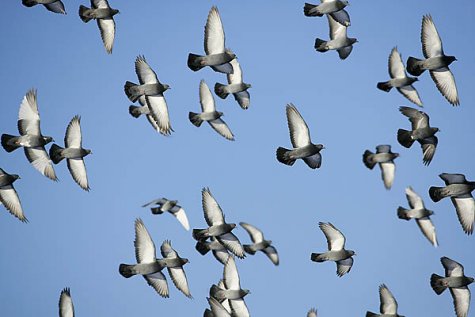Domestic pigeons in the city
Photo: Arne Ader
Translation: Liis
Domestic pigeons
Domestic pigeon; Street pigeon; Feral pigeon Kodutuvi Columba livia
Associated with humans, or synanthrope; spends the winter in cities and villages.
Upper body is basically grey, rump area white, wings grey on top side, underside light. Characteristic broad bands on the wings. Tail grey, dark at the tip and during flight usually spread out like a fan. Eyes dark red, beak dark grey, legs pink. Crop area and breast often with a metallic sheen that generally is slightly more modest on the female – both sexes have similar plumages and they are difficult to distinguish.
Domestic pigeons have developed from the rock pigeons (Columba livia) nesting in Western Europe and carrier pigeons escaped from pigeon houses: on crossing of the species the domestic pigeons of today have developed. Because of this the plumage colour of the birds also varies strongly – from white to nearly black.
Domestic pigeons are probably the first alien bird species to have settled in Estonia, having been brought in as cage birds from Germany, but already in the beginning of the 20th century quite common inhabitants in our cities.
In winter domestic pigeons in city landscapes are difficult to count as they move constantly hunting for food. Territorial moves occur often and permanent flocks don’t form. As an estimate about 100 000 domestic pigeons live in our cities and communities. During the last quarter of century a slight decline in numbers has been noted.
Domestic pigeon observations: LINK









